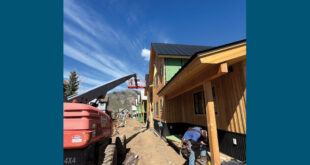Some report seeing lion on Columbine Hill
[ By Katherine Nettles ]
It appears mountain lion interaction season might be drawing to a close, as heavier snowfall has arrived in the north valley and reports of interactions between people and mountain lions this fall and early winter have paused recently. Officials are guessing that the uptick we saw was due to warmer, dryer conditions than usual and lions trying to protect a food source or young cubs. There were reports of sightings even after the ski area opened, as some people said they spotted a lion on Columbine Hill north of the Red Lady Lift.
Joe Lewandowski, public information officer for the Colorado Parks and Wildlife (CPW) southwest region, said there are a few possible reasons for all the mountain lion sightings that have shaken up more than a few locals this year.
“We live in mountain lion habitat, and deer are the favorite food of them,” said Lewandowski.
“We’ve had sort of a strange fall, because we haven’t had a lot of snow. And deer are migrating to the south, but they are migrating a little later. And people are also able to hike and bike more than they normally could this time of year.
CPW does not think the increase is because of wildfires in other areas of the state, however. “Those fires have been really far away,” says Lewandowski.
“We can’t say why there are more mountain lions this year. The biggest reason we believe is there are more people on the landscape right now.”
It does appear the big cat (or cats) have been keeping to themselves lately. After several people reported uncomfortable interactions with a lion at Crested Butte Mountain Resort (CBMR) and hikers and bikers reporting sightings along the Happy Hour Trail near the Upper Loop, there have not been any official reports in more than three weeks.
Regarding the numerous sightings this year, CPW officials have guessed that it could be the same lion. A houndsman this fall discovered a fresh kill near the Happy Hour Trail sightings.
“There have been sightings in that area. If an animal keeps finding the prey it needs, it is going to stay in that area,” says Lewandowski.
He emphasizes that most of all, “What people need to do is report it to us if they have had a sighting or an interaction that was uncomfortable. If we find out a week later there is nothing we can check for. If people have a concern for what they are seeing, they should call us at the Gunnison office.”
Tracking a lion is difficult, says Lewandowski, and it takes a long time. If more sightings or reports of aggression, particularly to livestock, come in, there might be cause for tracking the animal. However, Lewandowski says, “We try to avoid euthanizing animals.”
“We usually will trap lions if they exhibit really aggressive behavior or if they kill livestock. But just seeing one on a trail, we aren’t going to capture that animal. The lion is being a lion.”
CPW issues about seven mountain lion hunting permits every year, but “We still have a healthy population here,” says Lewandowski. “They are a low density species. We have about 400,000 deer and 6,000 to 7,000 lions. So, each lion has a big home range that is their territory. They need that home range to make a living. So, they are territorial, and they require a lot of ground to find their prey and reproduce and find mates. But some of them do overlap.”
Lewandowski reminds people to remain aware of their surroundings, “and be aware that we live in an area where we have a lot of wildlife.”
If an encounter happens, he says, make yourself look big and then yell at it.
“If that lion is standing its ground, be aware it is probably protecting its food or its young,” he says.
 The Crested Butte News Serving the Gunnison Valley since 1999
The Crested Butte News Serving the Gunnison Valley since 1999

